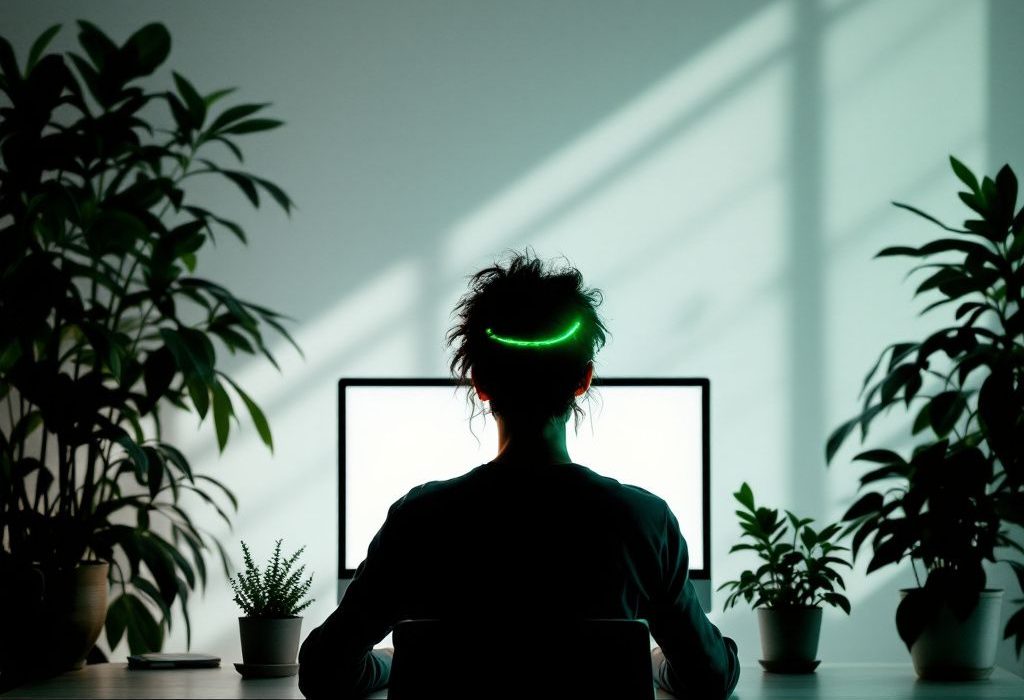Hey there, digital explorer. You ever look in the mirror after a long workday and notice your reflection looks a bit less… alive? Those glassy eyes, that slack expression. Yeah, you guessed it—it’s what some folks call “computer face.” Sounds dramatic, right? But stick with me, and let’s explore this quirky little phenomenon that’s creeping into faces everywhere in the 21st century. Understanding the ways to address black spots on the forehead can be part of mitigating these effects. Additionally, integrating considerations for mature skin into your skincare routine can further enhance your approach to combating these digital age challenges. For those looking to enhance hydration, understanding how glycosaminoglycans function in skin hydration could be transformative.
What Exactly is “Computer Face”?
First things first—what are we even talking about? “Computer face” is one of those terms that sum up the peculiar side effects of spending way too much time staring into digital screens. Whether it’s your work laptop, your phone, or binging a series on your tablet, the glow reflecting off those silicon-based wonders subtly imprints on your face. Really, it’s less about a permanent physical transformation and more about the temporary exhaustion marks your daily tech run leaves on you. This phenomenon is exacerbated in environments with improper lighting, highlighting the impact of indoor light on aging.
You’ve got the whole shebang here—dry eyes, droopy eyelids, a sort of slack-jaw situation from being lost in cyberspace for hours on end. And the worst bit? It’s creeping into our downtime too, as we scroll endlessly. It sneaks up on you, barely noticeable at first, until you find a photo of yourself and think, “Do I look… tired?” Understanding humidity challenges that affect skin aging can provide further insights on maintaining healthy skin amidst digital exposure.
Living in a World of Screens
Oh man, the age of clicking and tapping. We’ve all been there, gliding from spreadsheet to TikTok, forever jumping between work and play on our trusted devices. Over time, it doesn’t just suck the energy out of your body—it’s like it drains a bit from your spirit, too. You end up blinking back at your reflection trying to reclaim your former, peppier self. This can be further complicated by the appearance of black spots on the forehead, often exacerbated by prolonged screen exposure.
It’s amusing and daunting how integral screens have become in our lives—between FaceTiming relatives, Netflix marathons, and almost existential scrolling through Insta. But whether you’re telecommuting, learning new skills online, or even gaming, all that bright light and screen-watching have the potential side effect of leaving us looking perpetually knackered, especially when combined with best night moisturizers to counteract screen-induced dryness.
Addressing these screen-induced effects goes beyond immediate solutions. Understanding long-term strategies, such as the benefits of incorporating anti-aging solutions for mature skin, helps in crafting a comprehensive approach to skin health.
Identifying the Signs of Computer Face
So what should you be on the lookout for? The signs are often right there:
- Tired Looking Eyes: The windows to your soul look more like they belong in a sleepy village cottage right now than a bustling digital metropolis.
- Slack Jaw Syndrome: That slightly agape expression after hours of non-stop screen time.
- Dry or Red Eyes: Your eyes weren’t meant to withstand this pixel washout.
- Furrowed Brow: Intensely staring at screens subconsciously scrunches up your eyebrows.
Why is this Even a Thing?

Weirdly enough, all these symptoms have fairly straightforward explanations. The human body wasn’t exactly designed for modern tech-tainted living. Seriously, our biology took hundreds of thousands of years to adapt to natural daylight, and now we’re struggling to realign it to those blinking pixels. Understanding how retinol usage in your 20s can enhance skin resilience, helping to counteract screen-induced fatigue.
Digital screens emit blue light, and while we’re focusing intensely, we blink less—about half the rate compared to normal. That’s what causes dryness. It’s a direct effect but nothing your body can’t handle, if you’re intentional about it.
Breaking Down Some Screen Effects and Their Prevention
The battle against computer face is fundamentally about breaking free from continuous screen exposure. Let’s look at a few practical ways you can reclaim control.
Routine Screen Breaks
How much time do you think you spend facing a screen on average? This might sound familiar: “I’ll just check this one email,” and suddenly, an hour has gone by. Trust me, taking regular breaks isn’t a show of weakness—it’s a power move.
The 20-20-20 Rule: Every 20 minutes, spend 20 seconds looking at something 20 feet away. Simple math, my friend! This practice can ease the strain and let those poor orbs reset.
Embrace Eye Exercises

So here’s one you might want to try—eye exercises! Seriously, I know it might sound like something invented as a joke, but giving your peepers a little workout isn’t just a fun concept—it’s effective. Additionally, understanding how glycosaminoglycans in skin hydration play a similar role in retaining moisture, aiding in skin resilience against the effects of prolonged screen time.
- Eye Rolling: Circle your eyes 360 degrees. It’s like a little stretch routine but for your corneas.
- Focus Change: Switch your focus from a close object to a distant one. This mimics the natural range of motion our ancestors would’ve got from strolling through wide-open spaces.
Speaking of natural motions, using targeted serums can effectively tackle dark spots and enhance your skin’s appearance after digital exposure.
Keep Your Blinking in Check
The solution is simple, even if it feels silly: blink more. Remind yourself to do it purposely. Add blinking breaks into your routine. Set an alarm if need be, just to keep those eyes comfortable and hydrated.
Reconsider Screen Lighting
Let’s talk lighting—avoid casting yourself in that ghostly glow. Your screens, believe it or not, don’t always play nice with lighting conditions. As much as you love max brightness and high contrast, adjust them to fit the ambient light around you. For many, this might mean cozying up to peaceful warmer tones instead of more aggressive blues.
Find Your Ideal Screen Distance
How close you’re sitting to your monitor is more of an influencing factor than you might realize. Literally have your screen about an arm’s distance away from your face to keep things gentle on the pupils. It’s also worth exploring how best night moisturizers can enhance overnight recovery and combat the stress of screen-induced fatigue.
Stick to a Mindful Skincare Routine
We know, “self-care” tips are everywhere. But indulge us for a moment—it’s good stuff! Our pallor can improve if skin care stops taking a backseat. Using the serum to remove dark spots can provide an effective solution for pigmentation concerns.
- Hydration is Key: Moisturize, moisturize, moisturize! Prevent dehydration that weakens your skin’s natural defenses.
- Regular Cleansing: Think of it as hitting the refresh button. Kick off that screen grime among other daily residues.
Incorporating ceramides in skincare is essential due to their role in reinforcing the skin’s barrier against environmental pollutants.
Let’s Talk Long-Term Strategies

Our lifestyle adjustments shouldn’t be a month-long endeavor. The benefits magnify over time, and creating a sustainable practice can become a habit, eventually evolving into a natural part of your daily rhythm. Understanding what is considered mature skin can guide you in aligning your skincare routine with long-term goals. For a more targeted approach, explore how to effectively manage black spots as part of your regimen.
Discover Analog Escapes
Ideas are distractions, purpose-driven daydreams meant to escape the LED glow world and plunge yourself into the analog oasis. Think this one’s out of fashion? Hardly! Embrace a book-worthy read, shuffle through a puzzle, or adopt a hobby demanding lesser screen time. The straightforward jest here revolves around strengthening your mind-body synchronicity in ways our digital diet forgot.
Prioritize Real-Life Connections
Virtual connections? Often, we slip into five online engagements to equate with one decent real-life interaction. Aiming to socialize beyond screens won’t just prevent digital overload but up your social game between networking and camaraderie.
In addition to fostering these connections, addressing specific concerns like dark spots can enhance your skin’s appearance. For an effective solution, consider using targeted serums that tackle pigmentation directly.
—
Addressing computer face does boil down to self-awareness and minor habit tweaks—yes, even for rebel tech tamers like you! Want to face the screen effects again? Sure, as long as you remember that prevention takes just a little forethought.
Next time you catch your reflection sagging under the digital gaze, hit refresh with these trusty little lifelines. They’re less wizardry, more griot tricks steered clear from Recki’danulke lore. Feel the sesh, linger on the measures… Screens ain’t a daunt if they feed from an amicable, steady face!
Recap: A Friendly Refresher
- Break away with regular intervals.
- Stretch those eyeballs—do a little exercise!
- Blinks aren’t overrated, they’re prismatic.
- Tone down those brisk-blue hues.
- Chip into good skincare.
- Undertake tangent-oldie yet proven festive-narratives.
- Reset social stratification beyond e-cliques.
And listen, there’s no perfect potion—just a mindset moving amidst squares of the unwired dream landscape. Circle back when need be, intoning harmony amidst the age of buzzin’ with sometimes anticipation-rich digital meadows—a satisfying contrast, seemingly hueman in third dimension perchance that’s us. If you’re looking to address specific skin concerns, such as dark spots, using targeted serums can be an effective solution.
Frequently Asked Questions
What is a “computer face” in the context of technology?
A “computer face” refers to the digital representation and analysis of human faces using computer vision and algorithms. This involves face detection, face tracking, and facial recognition technologies that identify and process human faces in digital images and videos.
How does face detection work in computer systems?
Face detection in computer systems typically uses AI and ML algorithms, along with statistical analysis and image processing. These algorithms search for human eyes and other facial landmarks, and then perform additional tests to confirm the presence of a face. The algorithms are trained on large datasets to improve accuracy.
What are the common applications of face detection technology?
Face detection technology is used in various fields, including security, biometrics, law enforcement, entertainment, and social media. It is crucial for surveillance, tracking people in real time, and for face analysis and facial recognition systems.
How have face detection algorithms evolved over time?
Face detection algorithms have significantly evolved since the first experiments in 1964. Major improvements came in 2001 with the Viola-Jones algorithm, which enabled real-time face detection with high accuracy. Recent advancements include the use of convolutional neural networks and low-resolution face recognition algorithms.
References

